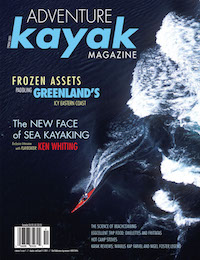Little people, read on. The low-volume, high-performance kayak may be a neglected category here in the land of ever-widening girth, but when you’re building boats for the Japanese market, designing small is a big idea. Steve Schleicher of Rainforest Designs created the Kap Farvel for Japanese buyers who wanted a smaller person’s day-touring kayak with a Greenlandic look (i.e., sharp, upturned bow and stern).
Schleicher gave the Kap knife-like ends and pronounced sheer (the upward sweep of the deck toward the ends). The Kap is not as difficult to paddle as it looks, however. The dramatic rocker places the paddler low in the water, resulting in surprisingly good initial stability and comfort in rough seas. The Kap tracks easily and requires only a slight tilt to carve a turn.
Surprisingly, our Kap gave us a dry ride in steep, one-metre whitecaps. Waves fold neatly around the razor-sharp ends and dissipate instead of breaking on the paddler.
It’s only above the waterline that the Kap ranks as a Greenland boat. Down below, it has a soft chine, which Schleicher says is more efficient than a typical Greenland hard chine, reducing hull surface area and turbulence. The Kap accelerates quickly and cruises comfortably at four knots, even against strong winds. Top speed is restrained by a short waterline, though I did hit eight knots on a following sea.
The Kap is guaranteed to make you a faster paddler. How? Its best-kept secret is that your partners end up carrying half your gear.
Other advantages: The Kap’s low windage made it easy to handle in 25-knot gusts; minimal weathercocking; fun wave play; ease of turning and control without the added complexity of a rudder or skeg.
At 6’2″, 180 lbs, I actually didn’t have any problem fitting in the Kap (shoes off) for a four-hour crossing on the Strait of Georgia, and felt like I could paddle circles around my partner in his much larger boat (see “best-kept secret,” above).
Somebody remind me: Why do we normally paddle enormous boats? It can only be because we want to carry enormous loads. But how much space do we really need? I know long-distance backpackers who wouldn’t dream of packing 100 litres.
The Nimbus Kap Farvel is a lightweight, nimble and attractive little boat that’s fun for small to mid-sized paddlers who have the skills to control a narrow, rudderless kayak. It offers many advantages of a recreational kayak (small size, light weight and easy handling) in a higher-performance composite package. Think of the fun we could have in these smaller boats if we gave up Krispy Kreme and ate more sushi.
If the boat fits, paddle it.
1. Small is beautiful
The sharp ends give a beautiful look, arcing clear of the water while the paddler sits low. Heavy- duty bungees on the rear deck provide a way to deal with gear overflow. The recessed metal deck fittings and paddle float rescue straps appear very sturdy. The carrying handles are large and comfortable. There is no skeg or rudder, but this boat is too short to need either, especially for the
shorter paddling distances to which it is suited. A skeg would save a bit of energy in a crosswind and make the Kap more beginner friendly, but you wouldn’t want to sacrifice the space needed for a skeg box.
2. Big in Japan
The foam cushion seat is quite comfortable and has a high back support. Taller paddlers (6’2″) can fit inside the snug cockpit, but will have to enter and exit bum-first, ocean cockpit style. The standard neoprene storage shelf is handy, although a paddler who is 5’10″ found it got in the way of his toes—ironically, tall paddlers whose feet extend beyond the shelf have the advantage here. There is a great deal of space behind the seat which can be used for storage, but it would be nice to see the rear bulkhead moved forward so this space could be incorporat- ed into the dry rear hatch.
3. Less is more
The multi-piece hatch system is a combination of a neoprene seal and a loose-fitting fibreglass cover that straps in place, all tethered together by bungee cord. Very dry, very secure, but a bit finicky compared to some one-piece designs. The capacity is quite small, limiting you to day trips and overnights unless you’re a true wilderness ascetic, a backpacker, or have friends with large boats. Think mothership paddling or else follow Thoreau and, “Simplify, simplify, simplify.”



